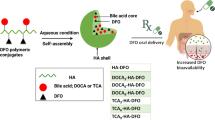Abstract
Iron and copper homeostasis have been studied in various tissues after iron-loading with the polynuclear ferric hydroxide carbohydrate complexes, iron dextran, iron polymaltose, iron sucrose and iron gluconate for four weeks. There were significant increases in the iron content of the different rat tissues compared to controls, with the exception of the brain, which showed no change in its iron content following iron loading. However, the level of iron loading in the different tissues varied according to the preparation administered and only iron dextran was able to significantly increase the iron content of both broncho-alveolar macrophages and heart. The hepatic copper content decreased with iron loading, although this did not reach significance. However the copper content did not alter in the iron loaded broncho-alveolar macrophages. Despite such increases in hepatic iron content, there was little evidence of changes in oxidative stress, the activities of cytosolic (apart from iron dextran) or mitochondrial hepatic superoxide dismutase, SOD, were similar to that of the control rats, confirming the fact that the low reduction potential of these compounds prevents the reduction of the ferric moiety. It was not necessary for macrophages to significantly increase their iron content to initiate changes in NO. release. Iron gluconate and iron sucrose increased NO. release, while iron polymaltose and iron dextran decreased NO. release although only the latter iron preparation significantly increased their iron content. It may be that the speciation of iron within the macrophage is an important determinant in changes in NO. release after ex vivo stimulation. We conclude that tissues loaded with iron by such polynuclear iron complexes have variable loading despite the comparable iron dose. However, there was little evidence for participation of the accumulated iron in free radical reactions although there was some evidence for alteration in immune function of broncho-alveolar macrophages.
Similar content being viewed by others
References
Askwith C, Eide D, Van Ho A. et al. 1984 The FET3 gene of S. cerevisiae encodes a multicopper oxidase required for ferrous iron uptake. Cell 76, 403-410.
Bacon BR, Tavill AS, Brittenham GM. et al. 1983 Hepatic lipid peroxidation in vivo in rats with chronic iron overload. J Clin Invest 71, 429-439.
Beauchamp C, Fridovich I. 1971 A mechanism for the production of ethylene from the generation of the hydroxyl radical by xanthine oxidase. J Biol Chem 245, 4641-4646.
Crichton RR. 2002 Inorganic Biochemistry of Iron Metabolism 2: from Molecular Mechanisms to Clinical Consequences, Wiley, New York and Chichester pp. 326.
Dancis A, Yuan DS, Halle D. et al. 1994 Molecular characterization of a copper transport protein in S. cerevisiae: an unexpected role for copper in iron transport. Cell 76, 393-402.
Geisse, P. 1998 Iron Therapy with special emphasis on oxidative stress. Vifor Int., St. Gallen pp. 142.
Geisser P, Baer M, Schaub E. 1992 Structure/histotoxicity relationship of parenteral iron preparations. Arzneim-Forsch 42, 1439-1452.
Harrison MD, Jones CE, Dameron CT. 1999 Copper chaperones: Function, structure and copper-binding properties. J Biol Inorg Chem 4, 145-153.
Kampfenkel K, Kushnir S, Baviychuk E. et al.1995 Molecular characterization of a putative Arabidopsis thaliana copper transporter and its yeast homologue. J Biol Chem 270, 28479-28486.
Knight SA, Labbe S, Kwon LF. et al.1996 A widespread transposable element masks expression of a yeast copper transport gene. Genes Dev 10, 1917-1929.
Kondo H, Saito K, Grasso JP, Aisen P. 1988 Iron metabolism in the erythrophagocytosing Kupffer. cell. Hepatology 8, 32-38.
Legssyer R, Henry C, Josse C. et al. 2002 Chloroquine induces significant changes in iron trafficking between hepatocytes and Kupffer cells as well as in the function of alveolar macrophages in an iron-loaded animal model. J Inorg Biochem in press.
Lin SJ, Pufahl RA, O'Halloran TV. et al. 1997 A role for the Saccharomyces cerevisiae ATX1 gene in copper trafficking and iron transport. J Biol Chem 272, 9215-9220.
Pierre JL, Fontecave M, Crichton RR. 2002 Chemistry for an essential biological process: The reduction of ferric iron. BioMetals in press.
Schonewille JT, Yo S, Beynen AC. 1995 High iron intake depresses hepatic copper content in goats. Vet Quart 17, 14-17.
Sibille JC, Kondo H, Aisen P. 1988 Interaction between hepatocytes and Kupffer cells in iron metabolism: a possible role of ferritin as an iron carrier protein. Hepatology 8, 296-301.
Stearman R, Yuan DS, Yamaguchi-Iwai Y. et al. 1996 A permeaseoxidase complex involved in high-affinity iron uptake in yeast Science 271, 1552-1557.
Vulpe CD, Kuo YM, Murphy TL. et al. 1999 Hephaestin, a ceruloplasmin homologue implicated in intestinal iron transport, is defective in the sla mouse. Nat Genet 21, 195-199.
Ward RJ, Florence AL, Baldwin D. et al. 1991 Biochemical and biophysical investigations of the ferrocene-loaded rat: an animal model of primary haemochromatosis. Eur J Biochem 202, 405-410.
Ward RJ, Dexter D, Florence A. et al. 1995 Brain iron content of the ferrocene-loaded rat- its chelation and influence on dopamine metabolism. Biochem Pharmacol 49, 1821-1826.
Ward RJ, Scarino ML, Leone A. et al. 1998 Copper and iron homeostasis in mammalian cells and cell line. Biochem Soc Trans 26, S191.
Whitaker P, McArdle HJ. 1997 Iron inhibits copper uptake by rat hepatocytes by down-regulating the plasma memebrane NADH oxidase In Fischer PWF L'Abbé MR Cockell KA. et al. Trace Elements in Man and Animals. NRC research press, Ottawa, Canada: 273-239.
Zhang Y, Crichton RR, Jorens PJ. et al. 1998 Decreased release of nitric oxide by alveolar macrophages after in vivo loading with iron or ethanol. Biochem Pharmacol 55, 21-25.
Author information
Authors and Affiliations
Rights and permissions
About this article
Cite this article
Legssyer, R., Geisser, P., McArdle, H. et al. Comparison of injectable iron complexes in their ability to iron load tissues and to induce oxidative stress. Biometals 16, 425–433 (2003). https://doi.org/10.1023/A:1022547819506
Issue Date:
DOI: https://doi.org/10.1023/A:1022547819506




